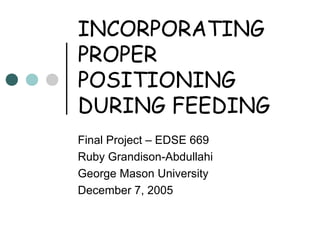
Incorporating proper positioning during feeding
- 1. INCORPORATING PROPER POSITIONING DURING FEEDING Final Project – EDSE 669 Ruby Grandison-Abdullahi George Mason University December 7, 2005
- 2. ABOUT MORGAN Age: 10 years old Placement: Self-contained classroom for students with severe disabilities Mode of mobility: Ambulatory Method of Communication: Makes vocalizations like a soft hum, and turns head from side to side. Claps when excited and cries when upset. Morgan is able to hit a voice-activated switch when prompted. Diagnosis: Chromosomal disorder (Inverted duplication of Chromosome 8p11.2-p23)
- 4. Significant characteristics of Chromosome 8p duplication Mental and growth retardation Aplasia of corpus callosum: incomplete development of the corpus callosum (a mass of fibers connecting to the brain’s hemispheres.) Orthopedic problems like scoliosis, and joint contractures leading to permanent deformities. Highly arched cleft palate
- 5. Characteristics, continued Mandibular prognathism: The mouth and jaw are projected beyond the upper face. Bifid uvula: The small, fleshy process hanging down the soft palate above the back of the tongue is divided into 2 equal parts by a cleft.
- 6. Morgan’s Eating History Morgan has always had difficulty eating. At school, she eats school lunches that have been pureed in a small blender to a semi-lumpy consistency. She can eat noodles that are chopped very fine. At home, she eats yogurt, eggs, applesauce, potatoes and other soft foods.
- 7. Eating History, continued Morgan also has difficulty drinking from a cup. She shows no interest in having a cup in front of her, or touching a cup. She pushes it away whenever a cup is introduced. She takes liquids by mouth with a regular spoon. Most liquids are added to food. (i.e. milk added to pudding). Melting frozen juice drinks have also been successful for liquid intake.
- 8. Eating history, continued Morgan will grasp a spoon with assistance and take it to her mouth. She releases the spoon once the food is eaten off the spoon. She opens her mouth independently to take food. She does not chew, but sucks the food in her mouth, then swallows it. If she does not want the food, she will gag and eject the food.
- 9. The Goal: To incorporate a proper positioning plan for Morgan’s feeding times Provide oral support Provide adaptive seating Participate in regular lunch program in school cafeteria
- 10. Morgan’s Feeding Positioning Plan Oral and facial stimulation will be applied initially by O.T. or O.T. assistant. Morgan will walk to cafeteria with her class. She will be placed in an adapted seat for lunch. (Used also in the classroom)
- 11. Feeding Positioning Plan The Rifton chair used for seating provides the needed support to maintain her in an upright position during eating.
- 12. Benefits of Using Adapted Seating Pelvis can be tilted slightly forward. Pelvis can be centered on the back edge of seat. Knees can be flexed to 90°. Feet and toes can face forward. Trunk can be placed in a symmetrical position, not curved to the side.
- 13. More Benefits of Adapted Seating Positioning of the arms Forearms can be relaxed on the tray or on the armrest of the chair. The present chair may have to be modified so that adaptive armrests, (maybe Velcro straps) can be placed on the tray, since Morgan often grabs the spoon, the food, or feeder. This could be faded out as Morgan adjusts to this positioning, and attempt to place the spoon in her mouth with or without assistance.
- 14. Additional Benefits of Adapted Seating Position Food can be placed on the tray in a suction bottom bowl to alleviate grabbing, or spilling of food. Feeder can place hand on top of Morgan’s head to provide head control. Additional head support can be provided by a positioning aid on the back of the chair, like a head rest, or head strap.
- 15. Implementation of Plan The O.T. will provide training for oral stimulation to school personnel. The P.T. will make the necessary modifications/adaptations to the Rifton chair so that it will be more suited for Morgan during feeding. The specialists will also train individuals on the proper technique to place Morgan in the chair. The O.T. and P.T. will consult with parent and provide the necessary trainings so that the same plans are incorporated at home. The plan will be implemented initially in the school cafeteria, then transferred to the home and other community environments.
- 16. Collaboration of the Team Team Members involved: Morgan Parents and family Special Education Teacher Paraprofessional O.T. P.T. Classroom volunteers
- 17. Collaboration, continued Investigate the specific feeding techniques that have proved to be successful with Morgan. The team should meet and review plan on an ongoing basis. Family should be involved so that the plan can be implemented at home, so that the family can enjoy mealtime with Morgan. Efforts should be made to ensure that family has the necessary equipment to carry out the plan.
- 18. References Multiple Congenital Anomaly/Mental Retardation (MCA/MR) Syndromes. Retrieved on December 2, 2005 from http: www.nlm.nih.gov/cgi/ Jablonski/syndrome Orelove, F., Sobsey, D. & Silberman, R.K. (2004). Educating Children with Multiple Disabilities – A Collaborative Approach. Baltimore: Paul H. Brookes Publishing Company. Snell, M.E., & Brown, F. (2000). Instruction of Students with Severe Disabilities. Upper Saddle River, NJ: Prentice-Hall, pp. 343-352 & pp.264-287.